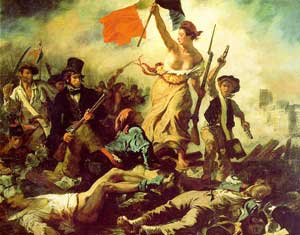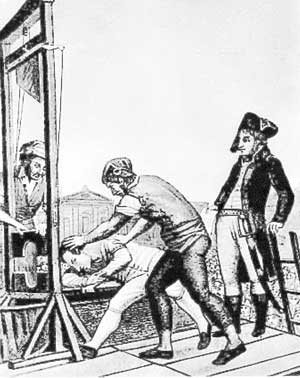So we go back to Paris in the middle of the 18th century when the ancient concept of monarchy seemed so out of sync with the economical and social progress taking place in the country.
The Enlightenment was full of antiestablishment ideas that were prompting people to re-examine the principles and practices of the ancien régime. Unsurprisingly it was found wanting.
But entrenched traditions, a clumsy social hierarchy and royal languor prevented change from starting until the 1770s, by which time the monarchy’s historical clock was well and truely ticking.
The Seven Years’ War (1756–63) was one of a series of horrible French military defeats which resulted in the loss of France’s colonies in Canada, the West Indies and India.
In part to avenge these losses, the next Louis, Louis XVI, sided with the colonists in the American War of Independence (1775–83) but the radical democratic ideas that had taken hold across the pond seemed to be seeping into France.

On 14th July 1789 the masses, spured on by the talk of democracy and equality in places like Café de Foy at Palais Royal, took to the streets of Paris.
The mob raided the armoury at the Hôtel des Invalides. They acquired 32, 000 muskets, and then stormed the prison at Bastille – the ultimate symbol of the oppressive ancien régime. The French Revolution had begun.
In its initial phase, the French revolution was supervised by the moderate republicans -- a.k.a Girondins. They declared France a constitutional monarchy and various reforms were announced but no one was truly convinced. External threats to the new government - Austria, Prussia and the exiled nobles - only radicalised the rebels.
Enter Maximilien Robespierre, Georges-Jacques Danton and Jean-Paul Marat with their gang of Jacobins and so starts the Reign of Terror.
The Jacobins abolished the monarchy and declared the First Republic in 1792. Early the next year, Louis XVI made the mistake of trying to flee the country. He was captured and convicted of ‘conspiring against the liberty of the nation’ and then guillotined in on 21st January 1793.
Marie Antoinette was executed in October the same year. Robespierre and his henchmen then set about guillotining thousands of 'counter-revolutionaries' on the grounds of national security. The French revolution seemed to be taking on a much more violent turn than at first intended, and not only because of the execution of the royals, but rather because of what was about to come: the reign of terror.

By autumn 1793 the Reign of Terror has reached its most desructive phase. About 2500 people were beheaded in Paris the next year. In the end, the French Revolution turned on itself, ‘devouring its own children’.
The reing of terror turned revolutionaries against each other. Danton was sent to the guillotine by Robespierre and not long after Saint-Just and Robespierre eventually went the same way.
Paris celebrated for days afterwards.
As the Reign of Terror faded, a five-man organization of moderate republicans, called the Directory, was set up to rule the Republic. Napoleon was put in command of the French forces in Italy as a thanks for saving the day, and a political monster was born.